Broughton Parish Library: preservation and conservation
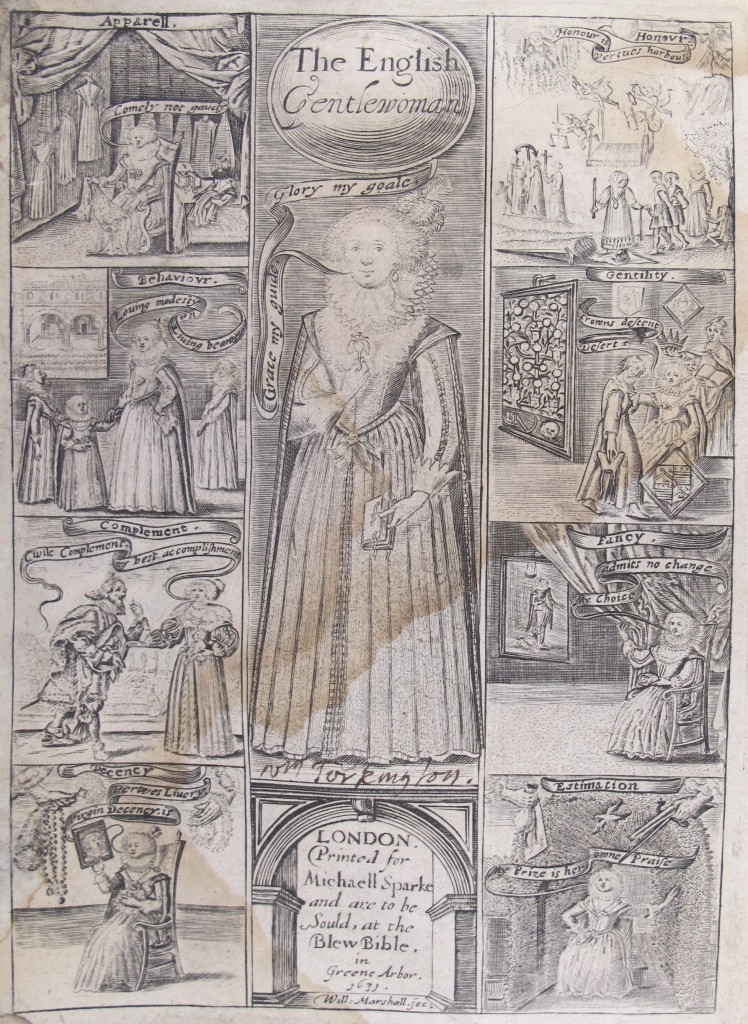
Engraved title to Braithwaite’s English gentlewoman (London: 1631), inscribed by William Torkington (Broughton.57)
The collection of rare books held by Cambridge University Library has been built up over more than six centuries by a variety of means, including purchase, donation and bequest of anything from single volumes to vast libraries of tens of thousands of volumes. In the latter half of the twentieth century, several significant institutional collections were acquired by the library, including books from Bury Grammar School and the libraries of Ely & Peterborough Cathedrals (all three deposited with us in 1970) and the parish library of Bassingbourn (purchased in 1969). One other large acquisition was that of the parish library at Broughton, a small village about six miles north of Huntingdon, which came to us in 1958. Parish (or Parochial) libraries were established in the seventeenth and eighteenth centuries for a number of reasons and in a variety of formats; some were collected as personal libraries by vicars before being left to their church for public use, and others were put together specifically for the edification of clergy. By the later nineteenth and early twentieth centuries, many such collections were neglected and sold off, but some made their way to institutional libraries where they continue to be studied today, especially for their copy-specific features including provenance and bindings. The original transfer of books from Broughton has recently been supplemented with a further seventeen bound volumes and a number of unbound pamphlets and pieces of printed and manuscript ephemera, which remained on display in the church after 1958. A note on the conservation of this recent acquisition follows this piece.
The library at Broughton, founded in 1737, was the gift of the Rev. William Torkington, a Cambridge man born c.1666 who matriculated at St John’s College in 1684. He served the village of Wistow (about twenty miles north-west of Broughton) as its rector for over thirty years, from 1705 until his death in 1737. In his will he gave “…to the Reverend Mr. Hodson of Broughton in the County of Huntingdon all my printed books of which he hath none of the kind towards the setting up [of] a public library”. It is unusual that he chose to send the books to a nearby church, rather than establishing a library at his own, but the reasons for this are unknown. Robert Hodson, one of three members of the Hodson family to provide Broughton with rectors from the 1680s through to the 1770s, served Broughton for an astonishing 61 years and by the time of his death in 1774 had made arrangements for the library to be set up in the chancel. Although no records survive which might tell us about how the books were used or administered, we might surmise that Torkington had in mind something like the system in use at St John’s Bedford, where a parochial library was founded in 1700, as a copy of the printed catalogue (1706) is among his books. The Rector, Edward Bourne, was to be Library-Keeper, the books were to be kept in the vestry and were to be marked with the donor’s name and the name of the library (as at Broughton). Individuals could borrow two books at a time, and anyone writing a book could have six, if they gave a copy of their book to the library when it was published; folios could be borrowed for two months, quartos for six weeks and smaller books for a month. The trustees were to visit four times a year (on the first Tuesday in February, May, August and October) to ensure that “all the covenants, agreements, &c., are duly observed”.
The majority of the books are inscribed “The Rev. Mr. W. Torkington’s gift” and remain in the bindings they had during Torkington’s lifetime, some of which were executed in the sixteenth and early seventeenth centuries. Of the 650 or so volumes now at the University Library, the majority were printed in the seventeenth century, with many of the early eighteenth century. About thirty volumes date from the sixteenth century, of which just a handful was printed before 1550. The earliest book is a Latin edition of Ovid’s Metamorphoses, printed at Lyons in 1510. Although in rather a sorry state, this volume retains its original thick wooden boards and some of the leather which originally covered them. Of especial interest is a copy of Thomas Cranmer’s Answer…vnto a crafty and sophisticall cauillation deuised by Stephen Gardiner … agaynst the trewe and godly doctrine of the moste holy sacrament (London: 1551), which (according to a note by the eighteenth-century antiquary Thomas Baker) contains manuscript notes by Stephen Gardiner, the Catholic Bishop of Winchester under Queen Mary. In terms of subjects represented, the majority is of course religious and English, with many prayer books and works of devotion. One surprising inclusion is the now very rare fifth edition of William Clifford’s Little manual of the poor man’s daily devotion, a Catholic prayer book now recorded in just three copies. The earliest surviving edition (the third, of 1682) was unsurprisingly printed in Paris, but the fourth edition (1687), which appeared during the Catholic James II’s reign, was printed in London. The library contains items on both sides of the Catholic divide.
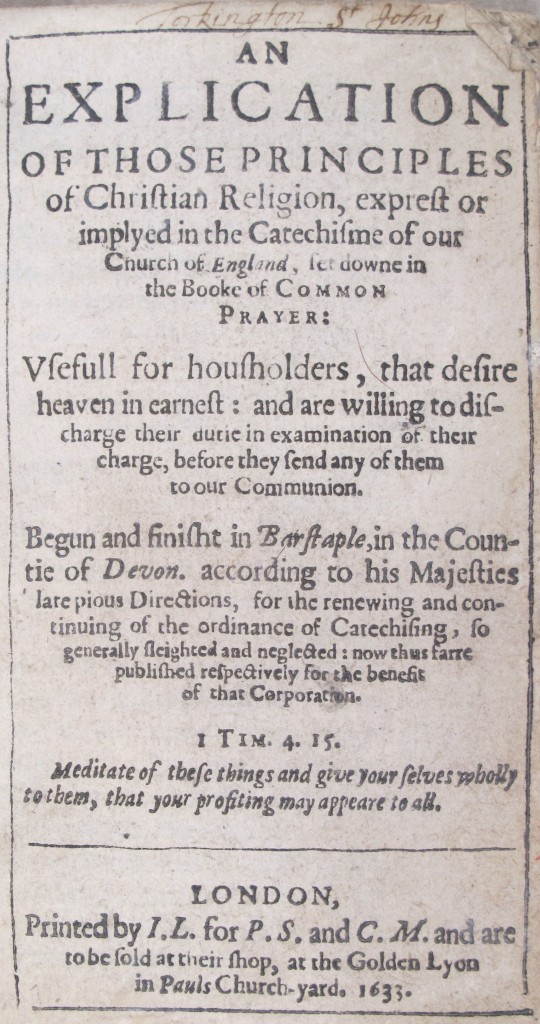
William Crompton: An explication of those principles of Christian religion… (London: 1633), inscribed by Torkington (possibly as an undergraduate at St John’s), Broughton.84
Non-religious subjects are also well-represented. Medicine, for example, is represented by a handful of volumes from the early years of the eighteenth century, including some more specific works on surgery. Books on law and justice appear too, perhaps suggesting the involvement of Torkington, as Rector of Wistow, in dealing with local disputes. Some books were probably acquired by Torkington with public use in mind, including perhaps Richard Braithwaite’s The English gentlewoman (London: 1631 – see picture above) and Obadiah Walker’s Of education: especially of young men (Oxford: 1677), though the latter could equally have been used by Torkington as an undergraduate at St John’s. The same may be said of the linguistic works in the collection, including the Calliepeia, or A rich store-house of proper, choyce and elegant Latine words of Thomas Draxe (London: 1643) and Some improvements to the art of teaching, especially in the first grounding of a young scholar in grammar learning, by William Walker (London: 1669). Two linguistic works prepared for use of boys at Westminster School may also have been added to the collection with local children in mind; the 1701 edition of Camden’s Institutio græcæ grammatices compendiaria and the 1659 edition of An English introduction to the Latine tongue. At least one book can, with some certainty, be said to have belonged to Torkington when he was a student at Cambridge; William Crompton’s Explication of those principles of Christian religion, exprest or implyed in the catechisme of our Church of England, set downe in the Booke of Common Prayer (London: 1633), which is inscribed “Torkington St John’s”. The sole edition of the text, it is now very rare, with just three copies known in the UK, one of which, interestingly, is at St John’s.
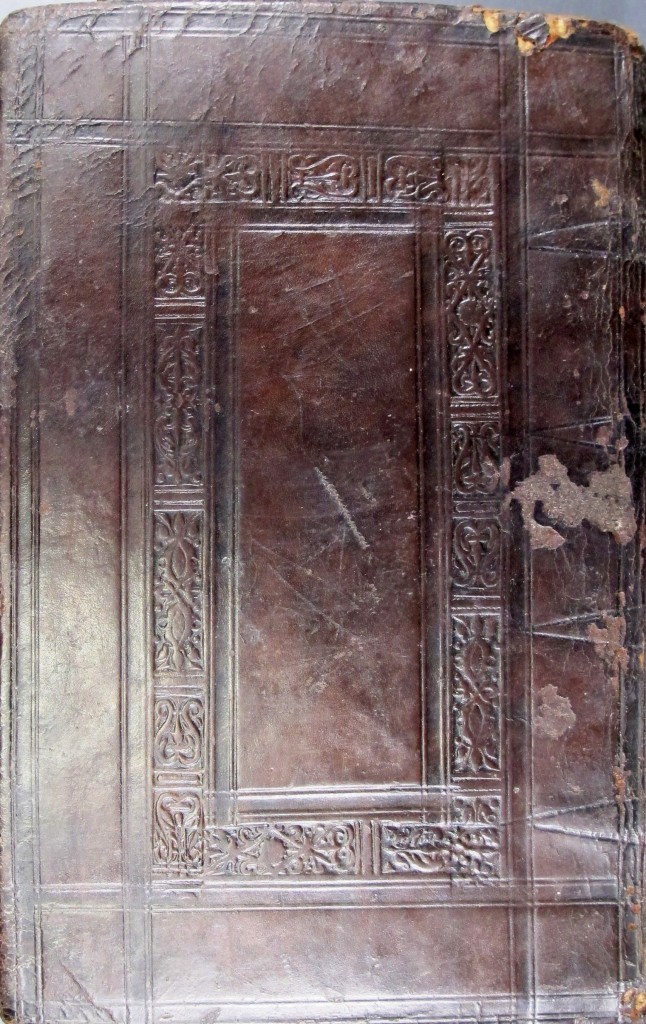
Blindstamped binding, probably executed in London in the mid-sixteenth century, on Erasmus’ paraphrases on St John’s Gospel and the Acts (Basel: 1548), Broughton.103
This connection with Torkington’s early days at Cambridge brings us more widely on to the subject of provenance. Many of the Broughton books bear marks of their pre-Torkington and pre-Broughton owners, including contemporaries at Cambridge and acquaintances among local clergy. A copy of the 1579 Basel edition of the works of Plutarch was inscribed in 1693/94 by Paulin[g] Phelips, then in his first year at Cambridge aged 15 or 16, and a volume containing the paraphrases of Erasmus on St John’s Gospels and the Acts bears an inscription by Phelips dated 1723/4. He was later Rector both of Marholm 1705-1734 and Woolley 1707-1734, both near Wistow, with Woolley about 11 miles to the SW and Marholm about 20 miles NW. Both men were at St John’s, though not at the same time (Torkington matriculated in 1684 and Phelips in 1693), so we might assume that the acquisition was made when both were Huntingdonshire rectors. Another volume contains a significant St John’s provenance, having belonged to the great book-collector William Crashaw (1572-1625/6); both boards are stamped with his device (an anchor covered by clasped hands, with his initials either side). It contains two works by the Spanish orientalist Benito Arias Montano, both printed in Antwerp, in 1601 and 1605. A large portion (about 1200 books) of Crashaw’s huge library was left to the college, but other books (presumably already held in the library) were not included, perhaps finding their way onto the second-hand book market in Cambridge, which must have been a good source of books for Torkington in his years at the University. One further book with a link to Torkington’s early days at Cambridge is the 1677 edition of the Historicae Philippicae, inscribed “Ex libris Thomae Smith Schola Publiae Beverlacensis alumni, Anno Domini 1684” and (in Torkington’s hand) “Ex dono Tho. Smith”. This is presumably the Thomas Smith who matriculated at St John’s a year after Torkington, having come, as the inscription suggests, from Beverley School.
Other interesting former owners, some in Torkington’s family and others more mysterious, are also present. A copy of the 1641 English edition of Desarets de Saint-Sorlin’s Ariane is inscribed by one Mary Torkington, in a hand of the later seventeenth century. This was possibly Torkington’s mother or sister. At the rear, in another hand, is a list of 67 titles, including this work, made by one Frances Wenyere in the seventeenth century. A small clutch of six volumes (Broughton.38, 44, 57, 90, 191, 208) possibly also with family connections to Torkington, belonged in the later seventeenth or early eighteenth century to various female members of the Pooley (or Poolie) family. The books, printed between 1614 and 1658, contain the names Elizabeth, Susan and Prudence Pooley, and one mentions a “Christopher Poolye”, who appears to have been the brother of Susan, and perhaps also of the other women. Evidence of learned female ownership of books in the seventeenth century is not terribly common, and although the identity of the women and their (possible) connection to Torkington remains unknown, these books are significant. One further curious provenance comes from the very rare 1674 edition of John Colet’s Daily devotions, which is inscribed in a late seventeenth- or early eighteenth-century hand “St Paul’s Coffee House”, appropriate given Colet’s position as Dean of the Cathedral and founder of its school. Such a provenance is interesting in the light of comments made by John Tillotson, vicar of St Martin in the Fields, who was inspired to found a library at his church (in 1684) after seeing too many young people in pubs and coffee houses. The book also bears the inscription of one “John Stacy”, probably untraceable, but just possibly the individual who was admitted to St John’s College Cambridge in 1712, some 28 years after Torkington. If so, the two may have been acquainted.
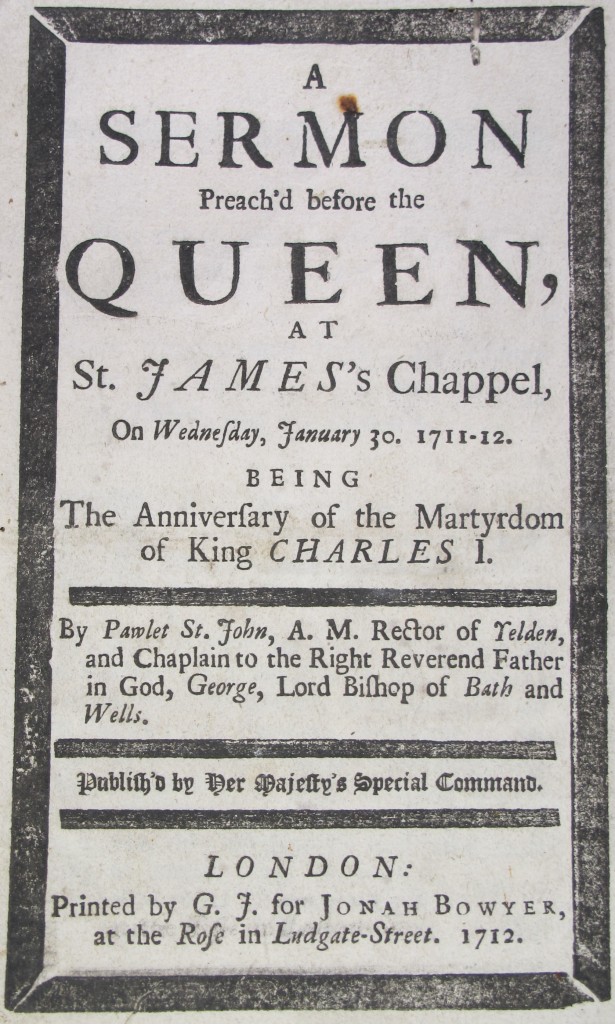
Sermon preached on the anniversary of the martyrdom of King Charles I (Broughton.643), one of the new acquisitions
The recent additions, which have now been catalogued onto Newton, include several notable works. Among them is a rare Christian dictionary of 1622, of which only four copies were previously known, two more sixteenth-century volumes and a large broadside Family-index to the Bible, printed at Northampton in 1739 and, until now, recorded in only one copy (at the British Library). Two more works by Benito Arias Montano rejoin the volume formerly owned by William Crashaw and Thomas Bennet’s Confutation of popery (1701) rejoins several other works by the same author, a Fellow of St John’s, including his Devotions (1702), which was sold by a Cambridge bookseller. Among the unbound sermons are six or seven preached on the anniversary of the martyrdom of King Charles I in the early eighteenth century. The more modern items include a group of ten ephemeral printed sheets and manuscripts once housed with the books in the church, which have now been conserved and boxed at the shelfmark Broughton.647. Among these are a poster advertising the Broughton Coronation Festivities in 1911, and two letters. The first is from Clarence House and is dated September 1980, thanking the Parish Council for their expression of good wishes on the Queen Mother’s 80th birthday; the second, from Buckingham Palace in April 1981, thanks the Parish for its good wishes on the engagement of the Prince of Wales to Lady Diana Spencer.
Having been enjoyed by Robert Hudson as his personal possession for almost forty years after Torkington’s death in 1737, the library at was evidently set up in the church for about a century, from the 1770s until the Victorian refurbishment saw it removed to the tower. However, it seems highly likely that it saw only a few decades of public use, into the early years of the nineteenth century, before (in common with many other parochial libraries at this period) its contents were neglected by the local people for whom it had been established in favour of improved opportunities of learning and access to books. Huntingdon, a mere 6 miles to the south west, offered a literary society (founded in 1817) and a circulating library (in operation before 1824). Circulating libraries in particular, giving lay people access to a wider range of books (including novels and other forms of popular literature), are likely to have been partly responsible for the decline of parochial libraries, which were largely limited to devotional works of earlier generations. When moved to the church tower the books suffered from damp and other depredations; when A. N. L. Munby, librarian of King’s College, visited the church in 1956, he noted that the books were “coated deep with a century’s dirt and pigeon droppings”, hardly ideal conditions for any collection of books (see his article, “Elias Burling, ‘A Call to Back-Sliding Israel’, New York, 1694: An Unrecorded Tract Printed by William Bradford”, pp. 251-253 in Studies in bibliography, vol. 14, 1961). In his word, the books were ‘salvaged’ by the Rector of the day, the Rev. Norman Marshall, and transferred to the University Library in 1958. The books still bear the scars of their century of neglect, many volumes having been damaged by mice, bookworm and damp, but the library – built up by a studious rector and bestowed with kindness on a nearby church for the edification of the local population – remains a significant monument to eighteenth-century philanthropy and learning.
Conservation (by Jim Bloxam)
Situation and environment
The books, pamphlets and ephemera recently transferred to the Library were housed within an early-twentieth-century glass-topped wooden display case within the Church. The books were upright, laid on their fore-edges; the pamphlets and other ephemeral material were loose within the case. Environmental conditions within the church were unsuitable for the storage and display of books and manuscripts, with significant fluctuations in temperature and relative humidity. All material in the case was damp to the touch and displayed signs of decay. The bound volumes were stored on their fore-edges, with commensurate warping of boards and dropping of text-blocks. Several bound volumes displayed active mould infestation and at least one book showed signs of recent insect damage.
Assessment and recommendations
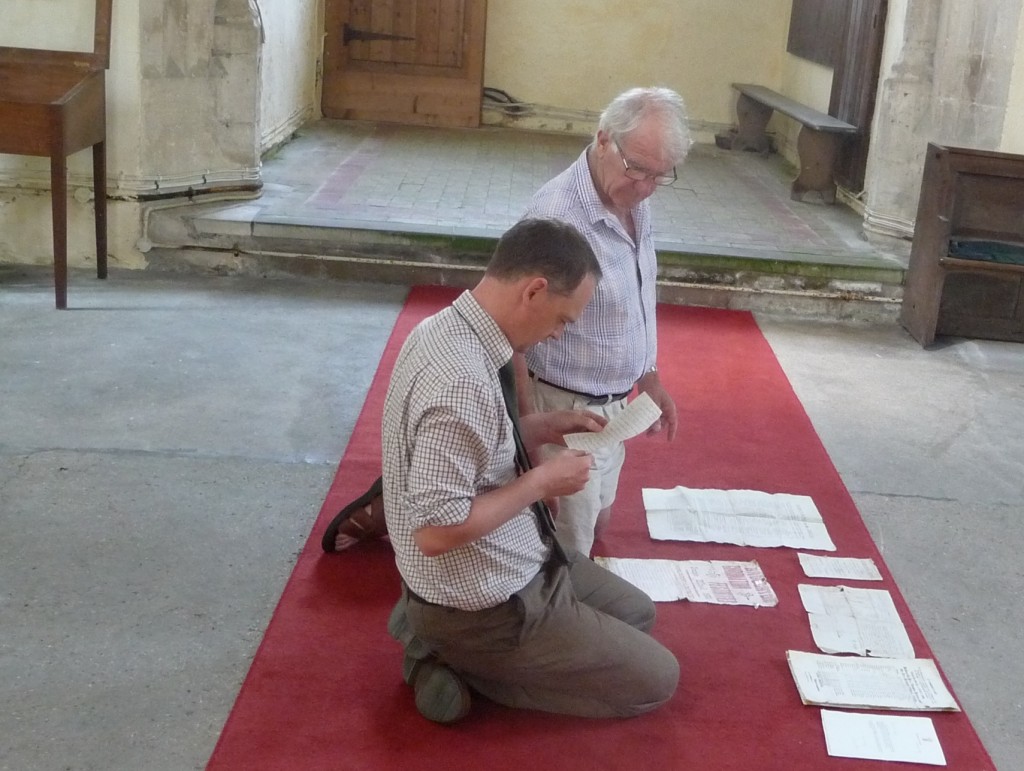
Ed Potten (foreground), Head of Rare Books at Cambridge University Library, inspecting material at Broughton Church
Following on from an initial assessment it was agreed that the best course of action was for the material to be further assessed, on-site, by a representative from Harwell Document Restoration Services (HDRS), with a view to it being removed from the church directly to HDRS for treatment. Emma Dadson, the Divisional Manager of HDRS joined Ed Potten, Head of Rare Books, and Jim Bloxam, Head of Conservation for a full survey of the collection. On completion of the survey it was agreed that the material should be transported directly to HDRS for deinfestation treatment and removal of mould.
Treatment, rehousing and future conservation
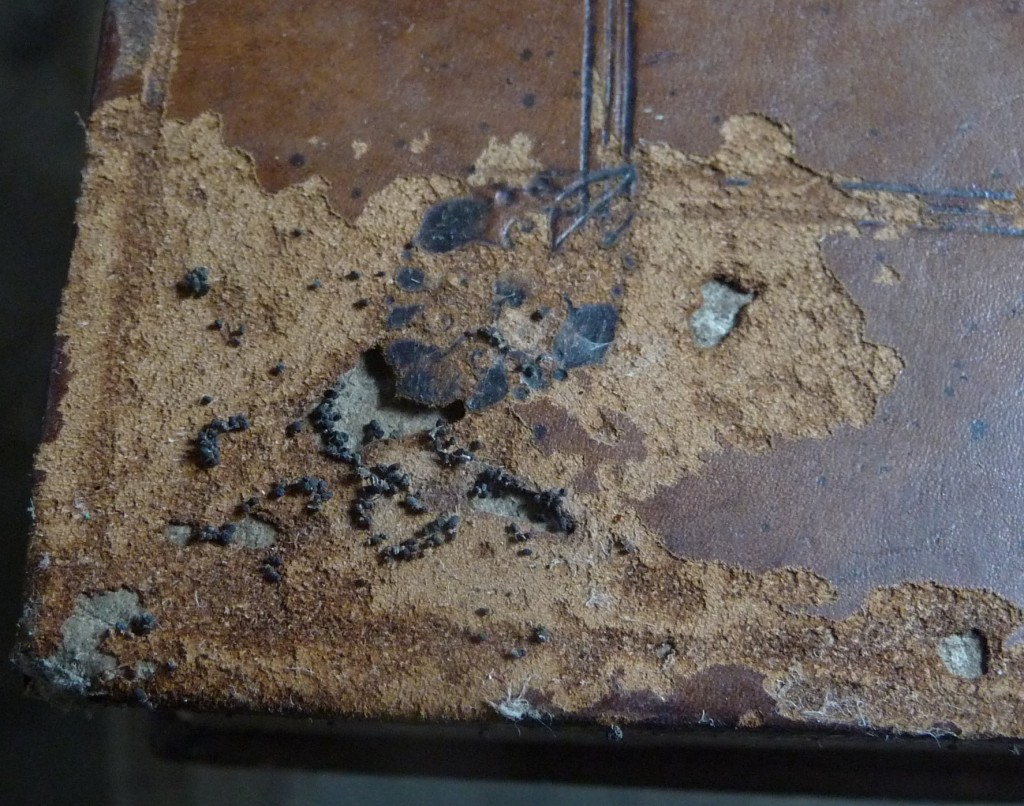
Detail of insect damage to the binding of Thomas Bennet’s Confutation of popery (London: 1701), since treated (Broughton.595)
The material, now treated for insect and mould damage, is safely housed in Cambridge University Library. Some material of high value and cultural importance will undergo some further conservation treatment.

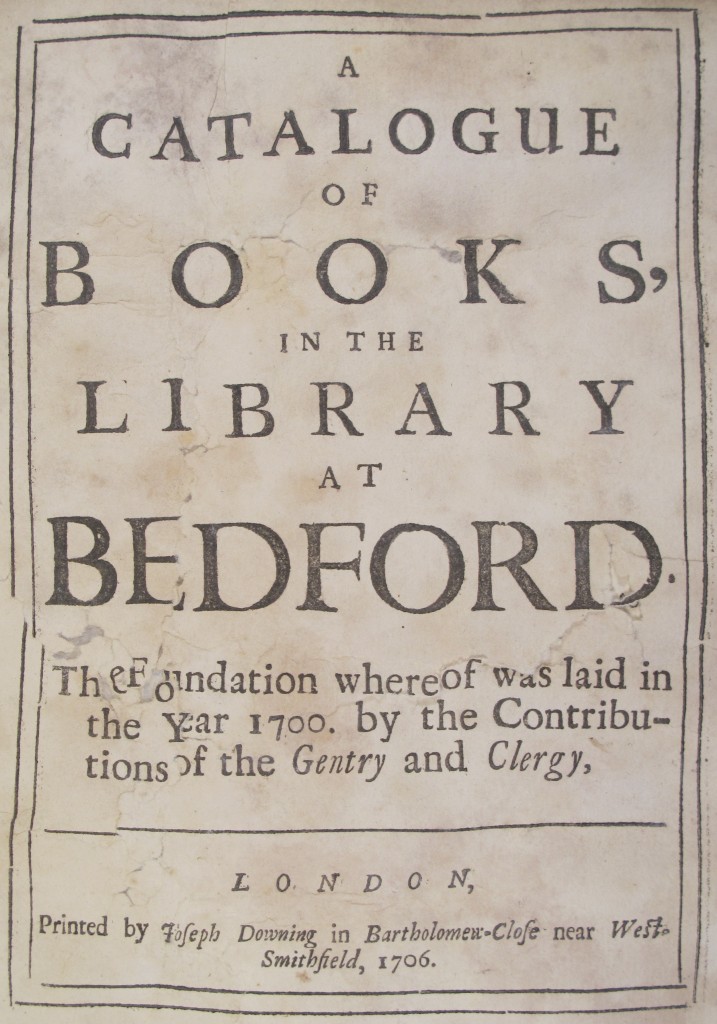
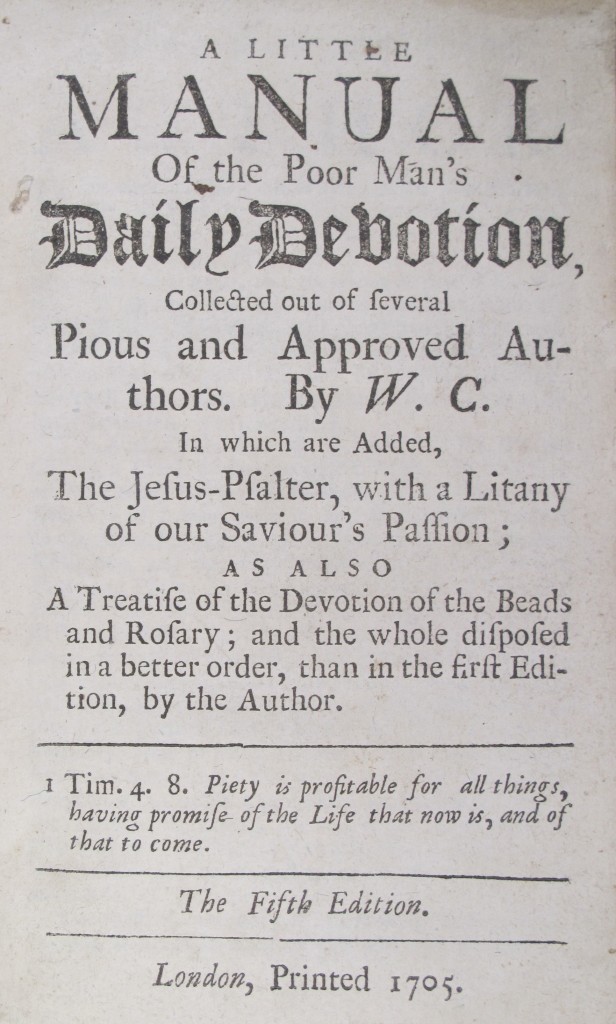
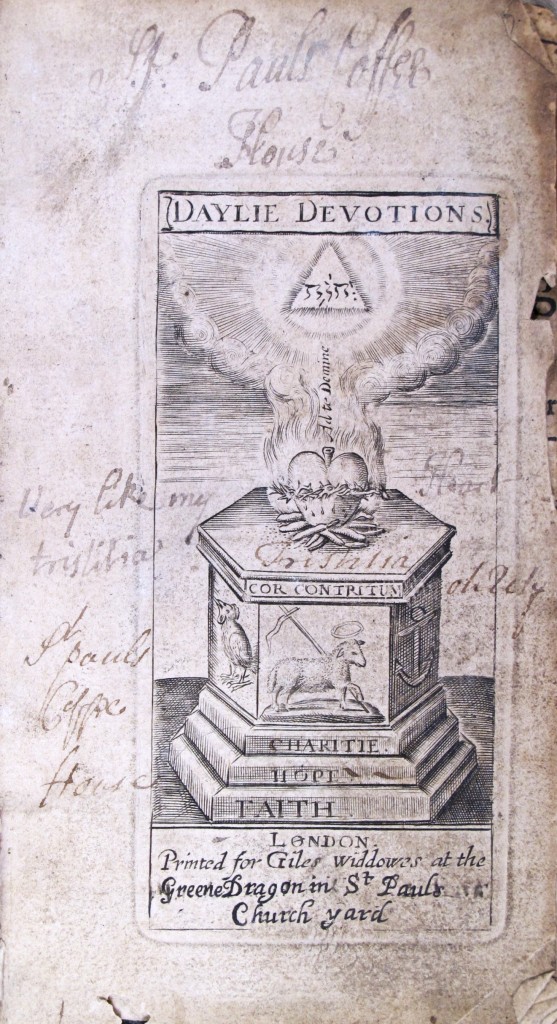
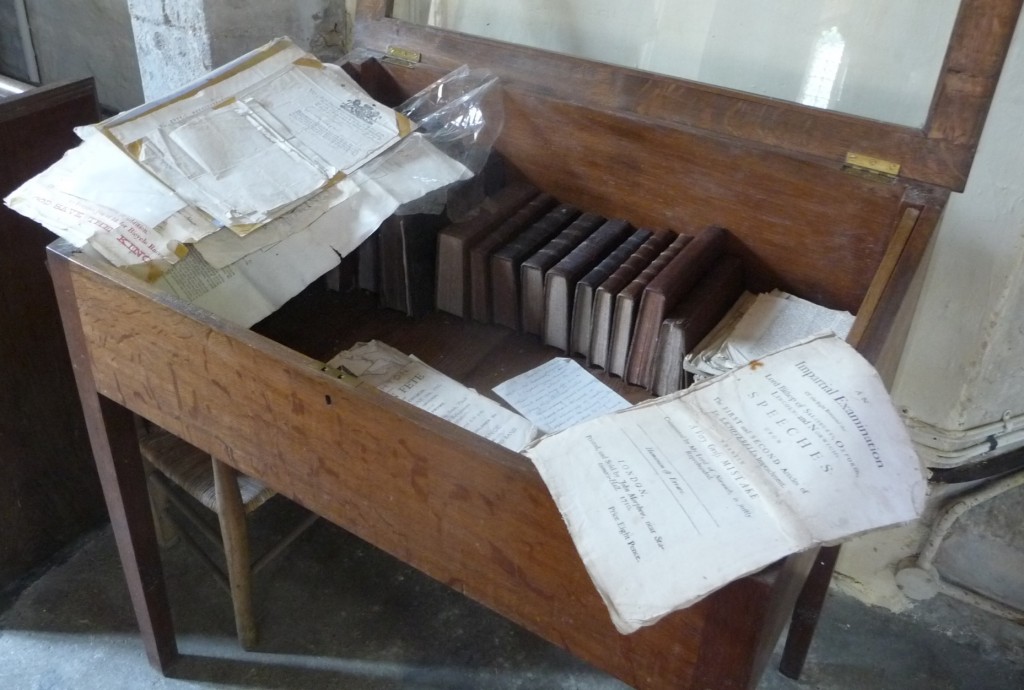
Very interested in your analysis of the Broughton books which you have preserved. I have written a book on the history of Broughton and from my research it appears likely that the Reverend Thomas Johnson added a building adjacent to the Rectory (which is called The Old Library)for the specific purpose of housing the books donated to the Reverend Hodson by the Reverend Torkington. This building was later used as a meeting place and clubouse until sold off as a private house. The books were then transferred to the Tower of the church where they were discovered in the 1950s. My records show that in the first batch of conserved books were first editions of Swift, Pope, Steele and Defoe and Bacon’s Essays.
Susan Robinson-Gillard
Thank you for your comment Susan. This is very interesting indeed. I’d be keen to have information on your book so I can read up on this. Does the building still survive in Broughton?